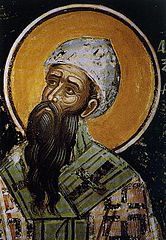
The Three Epistles Of Saint Cyril Archbishop Of Alexandria -Saint Cyril
PREFACE
THE Three Epistles of S. Cyril (the Commencement of the new edition of that portion of his works which it is hoped will contain his writings relating to the Council of Ephesus) are here published by themselves for the use of the Theological School. They differ from S. Cyril’s other writings, in that they have come down to us, like the Tome of Pope S. Leo, with the sanction of (one or more) Occumenical Councils and are consequently, these being the Act of the whole Church, binding on the whole Church. The former of the two Letters to Nestorius was read at the very opening of the Council of Ephesus, immediately after the recitation of the Nicene Creed (Actio prima initio t. iii. col. 1008 ed. Coleti). After approving this and reading Nestorius’ reply and Pope S. Celestine’s Letter to Nestorius, the last Letter of S. Cyril and the Alexandrine Council to Nestorius was read (Ib. col. 1048) and approved. The Council in the account sent by them to the Emperors of that memorable day (Ib. col. 1100) say, “And first comparing the Letters on the Faith of the Most Pious and Most Holy Arch-Bishop Cyril with this Exposition [the Nicene Creed] we found them consonant both in their doctrines and in their conceptions, and that his teaching was in nought estranged from that pious Exposition.” In the second Action of the Council of Chalcedon (t. iv. col. 1212) the former Epistle to Nestorius, and the one to John of Antioch were read, the Council acclaiming its agreement therewith. By the acceptance therefore of this Council by the whole Church, the Letter to John of Antioch received, in addition to the two others, the Authority of the Church. In the fourth Action of this Council very many of the Bishops in giving their Sanction to the Tome of Pope S. Leo said that they did so because it agreed with the Nicene Creed and that of Constantinople, and what was settled by the Holy Cyril in the Council of Ephesus. The Two Letters to Nestorius were again read over in the 6th Collation of the fifth General Council, and recited as Authority. The Bishops said of the Letter attributed to Ibas, which they were condemning, whoso receives it, receives not Cyril. (Collatio vi fin. t. vi col. 176).
The former Letter to Nestorius as well as the latter was written by S. Cyril in Synod as he himself says of it (p. 16) that the Synod at Rome had approved the Letters written to thy Piety by the Church of the Alexandrians. The History of these Letters and their period, being fully given in Dr. Bright’s History of the Church, with all the writer’s skill in grouping and weaving together contemporaneous events in different parts of the Church, and in his vivid language, need not be told here.
The MSS. collated are as follows:—
V = Cod. Vat. 1431. membr. sec. xi, collated for this edition by the accurate collator Dr. Hugo Hinck, Ph. D.
w = Cod. Vindobonensis Theol.
Nessel 18 Lambec. 88
bomb. sec.
Nessel 40 Lambec. 77
circ. xiv. (these two MSS. having formerly made up one volume). They were brought from the East by Augerius de Busbecke, Ambassador at Constantinople about the time of Queen Elizabeth. In the latter Epistle to Nestorius the affinity between V and w is so great as to indicate a common origin, but this does not run through the two MSS.
C = Cod. Coisl. 32 sec. xi.
I have used likewise the editio Commelina, published in 1591 from a good MS. which I have not identified but which has considerable affinity with C.
Besides these; for the first and last Epistles have been collated a MS. of the Council of Chalcedon viz.
x = Cod. Vindobonensis Historia Eccl. Ness. 27. Lamb. 57 sec. xi e fundo Aug. de Busbecke, and two others, viz.
g = Cod. Monac. 380 (olim Augustanus). bombycinus
Canones &c. continentes
k = E e iv. 29 Univers. Cantabrigiensis sec. xii. (g and k seem to have the same original).
In the great Letter to Nestorius
m = Cod. Reg. Paris 1308, sec. xv: a MS. of no importance.
From the Epistle to John of Antioch, the British Museum Cod. add. 14557, gives an early and very literal version (which I have called S). Dr. Wright in his Catalogue assigns this MS. to the 7th Century.
The Latin version of the two former Epistles is believed to be Marius Mercator’s and so to be of co-eval antiquity with the Letters themselves, for he was an early opponent of Nestorius and a younger contemporary of the great S. Augustine. These Letters were published with Mercator’s other works from two MSS., one in the Vatican, the other belonging to the Cathedral Church of Beauvais, by John Garnier, a Jesuit and great friend of Philip Labbe, one of the laborious Editors of the Councils, in 1673; and these two Letters were re-published ten years later from the same two MSS. by Stephen Baluz in his one volume of supplementary matter to the former editions of the Councils. In the former epistle there is a good deal of discrepancy between the two, which I cannot explain, as neither Editor gives in full the variances of the two MSS.
I have not re-collated these. Dr. Hugo Hinck had not at present identified the Vatican MS., and the one that belonged to Beauvais Cathedral, appears to be now lost. Of its MSS., a great number were taken to Paris and are now in the Imperial Library, the remainder were sold or destroyed at the Revolution as Canon Barraud informed me. If sold, it may hereafter be identified.
The Latin version of the Letter to John Archbishop of Antioch is from an old version of the Council of Ephesus, in Baluz.
OXFORD,
Sept. 1872.

 Support Site Improvements
Support Site Improvements